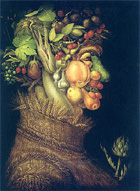 |
CSE557 Final
Project |
|
|
Composite Head |
by Colin Zheng, Nilesh Dalvi |
Introduction to the Problem
Take a photograph and try to render it using smaller images of distinct objects .
Renaissance painter Giuseppe Arcimboldo was famous for such compositions. The
“Composite Head” is that faces and human features are painted, not in flesh, but with rendered clumps of assorted vegetables,
fruits and other materials.
This is a non-trivial NPR problem......
Approach
Detailed steps of our approach is as
follows:
- Automatic Face Segmentation
We modified an existing implementation of mean-shift algorithm to
perform image segmentation to get a new image with fewer colors[1].
|
- Polygon Extraction
We performed connected component
analysis on the segmented image and detected the contour of each
component. The outline of each components were extracted as
polygon.
|
- Smoothing and Down-sampling
We smoothed out the outline of each component by averaging it out with
neighbors. Down-sampled the above curves by approximating it with polygons of
smaller order (using flatness estimates).
|
- Direction Curve Conversion
Direction Curve has the nice property of translation and rotation
invariance, so it's suitable to work here. We converted the polygons
into direction curves[2].
|
- Sprite Database Setting up
For the sprites database (consisting of fruits and vegetables), we
assumed the image of each sprites has background with constant color.
So we extracted sprite out of its background, extracted polygon out of
it. Did smoothing and down-sampling as above. We converted all the
sprites into the format of direction curves. They would be compared to
the face components.
|
- Curve Matching
For each face components, we did curve matching with all the direction
curves in the database, in order to find the largest partial match.
First matching vertex and rotation angle of the sprite curve were
recorded for bitmap composition.
|
- Bitmap Composition
With the starting vertex and the rotation angle, it was easy to place
the sprite bitmap onto the face component. More efforts were added to
ensure it was filled inside the component, and that part had not been
filled before.
|
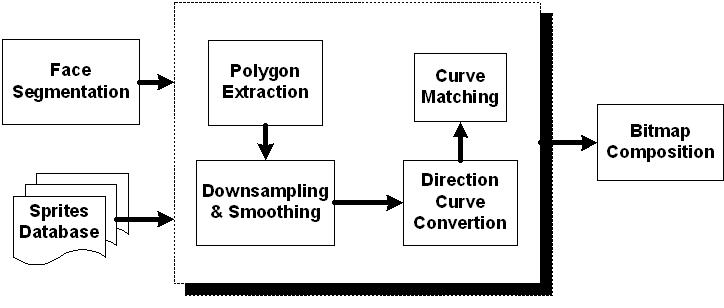
Fig 1. System Architecture Overview
Issues
- Limitation of Segmentation Algorithm
It's always hard to have a good segmentation algorithm that reflects semantics.
We gradually realize that "Composite Head" might need a
better segmentation which is not based on color cues. So sometimes, human
interaction is necessary in order to convey some semantics.
|
- Curve Matching
The direction curve matching has great advantages, such as solving
rotation and translation easily. But our algorithm still has flaws
like: if the face component is too large, the outline will be
perfectly matched with sprites while it will leave the center
untouched. This "hole effect" can be solved with hole
detection and filling.
|
- Bitmap Composition
We allow sprites overlapping while filling face components, but the
order to fill the components has great effects on the final visual
result. We paid little attention on that, but in the later version,
we'll use the depth in Z-Buffer to control the composite order. Ideas
like depth is proportional to size of the partial match will be
applied for better effect.
|
Demos
| Original Image |
Segmented Image |
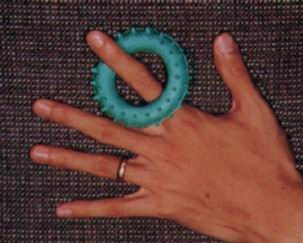 |
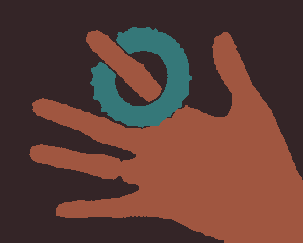 |
| Extracted Polygons |
Smoothed & Down-sampled Polygons |
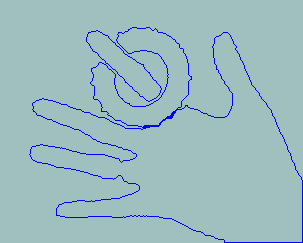 |
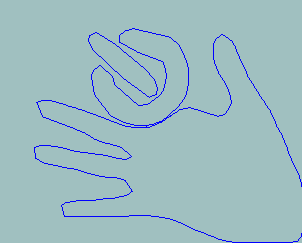 |
| Composite
Hand |
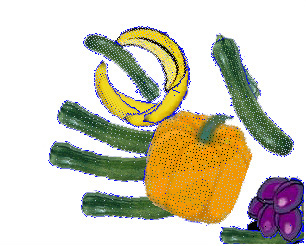 |
| Guess who is he/she??? |
 |
Reference
[1]. Dorin Comaniciu, Peter Meer, Robust Analysis of Feature Spaces: Color Image Segmentation, CVPR97, USA.
[2]. S. Umeyama, "Least-squares
estimation of transformation parameters between two point patterns," IEEE
Trans. Pattern Anal. Machine Intelligence, PAMI-13, 4, pp. 376-380, 1991







